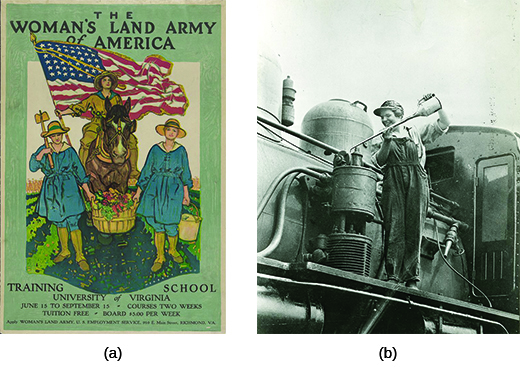| << Chapter < Page | Chapter >> Page > |
For women, the economic situation was complicated by the war, with the departure of wage-earning men and the higher cost of living pushing many toward less comfortable lives. At the same time, however, wartime presented new opportunities for women in the workplace. More than one million women entered the workforce for the first time as a result of the war, while more than eight million working women found higher paying jobs, often in industry. Many women also found employment in what were typically considered male occupations, such as on the railroads ( [link] ), where the number of women tripled, and on assembly lines. After the war ended and men returned home and searched for work, women were fired from their jobs, and expected to return home and care for their families. Furthermore, even when they were doing men’s jobs, women were typically paid lower wages than male workers, and unions were ambivalent at best—and hostile at worst—to women workers. Even under these circumstances, wartime employment familiarized women with an alternative to a life in domesticity and dependency, making a life of employment, even a career, plausible for women. When, a generation later, World War II arrived, this trend would increase dramatically.

One notable group of women who exploited these new opportunities was the Women’s Land Army of America. First during World War I, then again in World War II, these women stepped up to run farms and other agricultural enterprises, as men left for the armed forces ( [link] ). Known as Farmerettes , some twenty thousand women—mostly college educated and from larger urban areas—served in this capacity. Their reasons for joining were manifold. For some, it was a way to serve their country during a time of war. Others hoped to capitalize on the efforts to further the fight for women’s suffrage.
Also of special note were the approximately thirty thousand American women who served in the military, as well as a variety of humanitarian organizations, such as the Red Cross and YMCA, during the war. In addition to serving as military nurses (without rank), American women also served as telephone operators in France. Of this latter group, 230 of them, known as “Hello Girls,” were bilingual and stationed in combat areas. Over eighteen thousand American women served as Red Cross nurses, providing much of the medical support available to American troops in France. Close to three hundred nurses died during service. Many of those who returned home continued to work in hospitals and home healthcare, helping wounded veterans heal both emotionally and physically from the scars of war.

Notification Switch
Would you like to follow the 'U.s. history' conversation and receive update notifications?